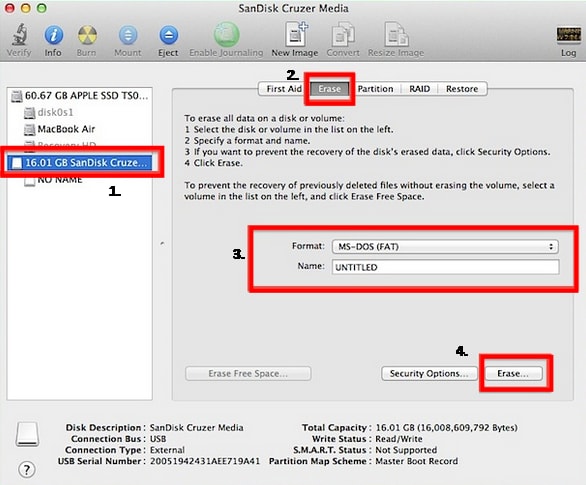Best Way To Format External Hard Drive For Mac
I installed EaseUSTodo program on Windows 7 With a My Passport -Essential external hard drive to (F), and now on Windows 10 that drive is full and I don't know how to format it to have room for more backup. I just bought an WD Elements hard drive with 1 TB of storage. I plan to split it into two partitions -- one for Mac backups and one where I can store files. To format an external drive on a Mac: Open Finder and go to /Applications/Utilities and double-click on Disk Utility. Select your drive in the left-hand sidebar and go to the Erase tab. To format the drive to work with both platforms you will need use a Windows computer to format the disk as exFAT. Update: At the time of the original posting in 2011, there were some problems getting a Mac formatted exFAT drive working with Windows, it had trouble recognizing those drives.
- How To Format External Hard Drive For Mac And Pc
- Why Format External Hard Drive
- How To Format An External Hard Drive
- Format External Hard Drive Mac
I want the hard drive to offer the following, in order of priority.
How To Format External Hard Drive For Mac And Pc
Possibly the best solution to using a hard drive with both Windows and Mac without the use of third-party software is creating two partitions on the drive, one for Windows and one for Mac. Use Disk Utility to Format an External Drive. After you connect an external drive to your Mac, open the Applications folder from the Finder window. The Disk Utility application is located in the Utilities sub-folder. Launch Disk Utility and then click to select the external hard drive listed on the left.
Why Format External Hard Drive
1) 2 partitions- one for Mac (Lion) and the other for Windows (7);
2) Backward compatible bootable for both platforms on other computers;
3) Can back up the computer (running lion) HD via time machine;
4) Can store images of other HDs for future recovery.
5) Can run either system applications on Mac (Lion)
How To Format An External Hard Drive

Format External Hard Drive Mac
In order to use your partition with Time Machine, you will need it to be formatted HFS. As for the Windows partition, the best bet is have ExFat. Though I would suggest getting NTFS support on your Mac and format the Windows partition with that.
Try formatting the drive in ExFAT. This format can be read by and written to by both Mac OS and Windows computers. You can format the drive via the Disk Utility built into Mac OS.
1. I suggest to format it within Mac OS X using Disk Utility: select to create 2 partitions, one in HFS+ the other on either with no file system or FAT (you will be able to format it as NTFS during the Windows installation. At the bottom click on 'Options' and select 'Master Boot Record' as partition scheme.
2. Backwards compatibility is limited by the operating system. Lion only works on Intel Macs. Windows 7 should work on most older hardware - however, as someone already pointed out an installed Windows operating system is not plug-and-play with other hardware.
3. Time Machine requires a HFS+ partition other than the boot drive. If you want to backup to the same hard drive you will have to create 3 partitions.
4. In general there is no problem storing images on the drive for future recover as long as the recovery software you are using can access the file system where the images are stored. Best keyloggers for mac.
5. Explanation? Lion can run all applications supported under Lion. If you want to run Windows programs under Lion you will have to install a virtual machine like VMware, Parallels or Virtual Box and make another Windows installation within those.
How to Share an External Drive Between a Mac and a PC
http://www.pcworld.com/article/250431/how_to_share_an_external_drive_between_a_mac_and_a_pc.htmlBecause of hardware-specific drivers, you will not find a whole lot of success with booting Win7 from that drive on other machines unless they are using the same hardware (identical machines in a corporate setting?). I'm not sure if the same thing applies to Mac OS X.
Sophos has a powerful piece of software for protecting your Mac. It has custom scans that you can schedule or use on-demand for individual files, folders or your whole Mac. Best free antivirus for Mac: Avast Free Mac Security Many antivirus suites provide a decent level of protection, but a few rise above all others by providing the very best in performance. It offers a full suite of Mac security tools, at the same price competitors charge for basic antivirus protection. These two are our Editors' Choice winners for Mac antivirus protection. 11 rows Norton Security is the best antivirus software if you have computers that run different. Best security tools for mac.
Because of item 4, you probably would want 3 partitions using one of them just for data and/or other HD images.
As far as the sizes of the partitions, it would depend on how you intend to use the operating systems, what apps you plan to have installed, and other factors. You may want to keep them as small as possible. (I use several VHD files to boot into other setups on my machine that are 40GB which is more than enough for the development and testing I do on them, but there are not many apps installed on any of those.)